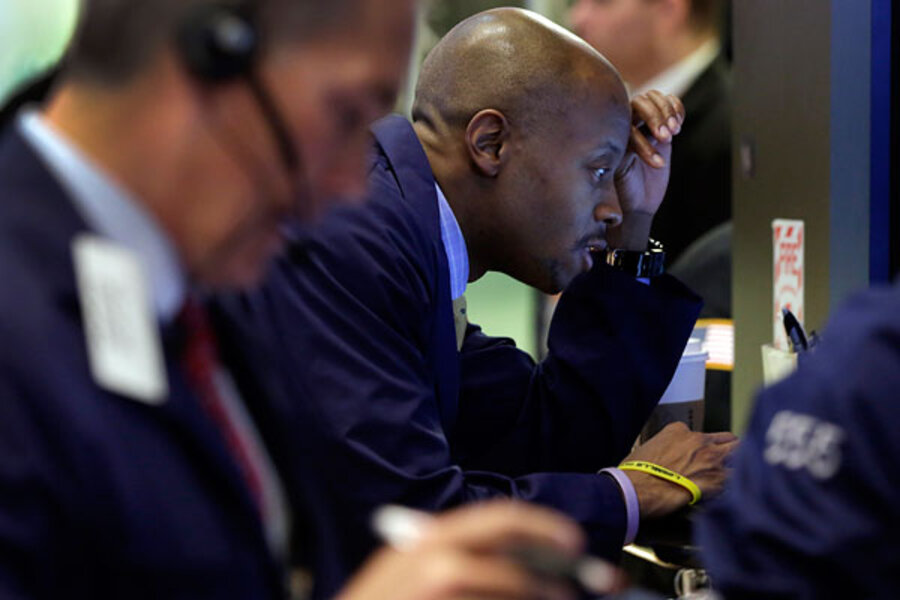Stock market's record bull run shows few signs of slowing down
Loading...
| New York
Despite the goings-on in Washington, the stock market has been setting numerical records.
Last Thursday, both the Dow Jones Industrial Average and the Standard & Poor’s 500 index had surpassed the Oct. 9, 2007, bull market high. Now, many investors are wondering how much longer this run can continue.
On the positive side, the stock market is carrying a lot of momentum into April. Since the beginning of the year, the Standard & Poor’s average is up 10.2 percent including dividends. The Federal Reserve is still keeping interest rates low. And, despite fears that the financial crisis in Cyprus might spread, the US economy seems insulated – so far.
But there are reasons for caution, too. The affect of sequestration – the automatic spending cuts in Washington – have not yet filtered through the economy. Stock analysts are anxious about the prospect for earnings going forward. And there is uncertainty over what might happen with North Korea, which appears to be edging closer to some form of confrontation.
“There are always dark clouds on the horizon,” says Fred Dickson, chief investment strategist at D.A. Davidson & Co. in Lake Oswego, Ore. “But so far only a couple of minor items are signaling caution.”
A recent analysis by Jeffrey Kleintop, chief market strategist at LPL Financial in Boston, looked at 10 indicators that often are red flags for investors. He found only two of 10 were red, three were yellow for caution, and five were green.
The two red flags: the apparent complacency of investors who risk being surprised by a negative event or data, and consumer confidence appears to be starting to fall.
Mr. Kleintop’s yellow caution flags include the possibility that expectations about the strength of the economy may be too high, that corporate earnings estimates may be too high, and that the difference between the two-year and 10-year US Treasury notes is starting to flatten. This would indicate the bond markets are expecting lower economic growth in the months ahead.
In another analysis, Sam Stovall, chief equity strategist at S&P Capital IQ, says he finds few signs that often precede a market peak. For example, he writes that the economy does not appear to be overheating, interest rates are low, and price to earnings-ratios are not at a level that would signal a peak in the market.
Historically, when the market has gained 9 percent or more in the beginning of the year, it has normally risen another 6 percent, Mr. Stovall says in an interview with the Monitor. This has been true 86 percent of the time.
The only times the market has failed to rise in recent years after a big gain early in the year were 1956, 1987, and 2011.
In 1956, the stock market had been enjoying a long run of rising prices. So it was not surprising when investors started to take profits, says Stovall, who notes that it was also an election year with some concern that Eisenhower would not be reelected. Later in the year, geopolitical concerns cropped up over control of the Suez Canal and the uprising in Hungary, which was quashed by the Soviet Union.
Investors began 1987 on an optimistic note. But in September, then-Federal Reserve Chairman Alan Greenspan started to raise interest rates. Some publications suggested President Reagan had a policy to lower the value of the dollar because of a soaring trade deficit. And some economists have found that the market’s fall coincided with anti-takeover legislation moving through Congress. The stock market crashed on what became known as Black Monday, falling 22 percent (508 points on the Dow) in one day.
In 2011, which started off with gains in January and February, investors became concerned after Congress became bogged down over increasing the US debt limit. Standard & Poor’s downgraded US debt. And, at the same time, there were concerns about the possibility of the European Union breaking up. It did not help that Japan suffered a terrible earthquake that disrupted global supply chains.
Mr. Dickson of D.A. Davidson thinks investors will get a better idea of how the markets will react when companies begin to report first quarter earnings and give guidance for their expectations for the second quarter.
“There are three areas that could be a real rally stopper,” he says. “First is if the guidance on second earnings is worse than expected,” he says. “The markets will also be concerned if North Korea steps up its actions, and then we have the political concerns such as the debt-ceiling debate in May.”
If the market was overly concerned about any of these issues, it did not show up in the averages on Monday. After being down about 40 points most of the day, the Dow Jones Industrial Average finished the day off 5.69 points and the Standard & Poor’s was down 7.02 points or about 0.45 percent.
“Based on a marginal decline in the S&P 500 and an even smaller decline in the Dow, this is not a characteristic of the beginning of a new bear market,” says Stovall.







